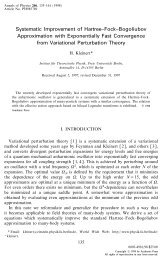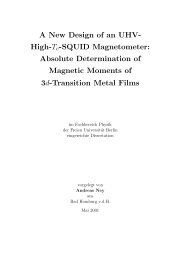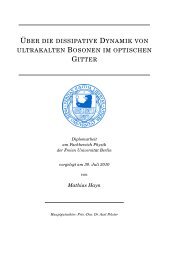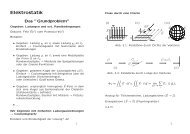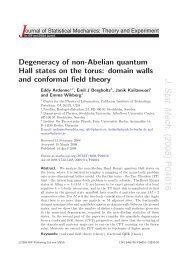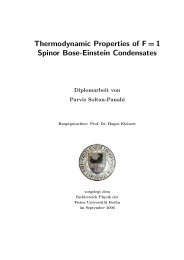Time-Dependent Electron Localization Function - Fachbereich ...
Time-Dependent Electron Localization Function - Fachbereich ...
Time-Dependent Electron Localization Function - Fachbereich ...
You also want an ePaper? Increase the reach of your titles
YUMPU automatically turns print PDFs into web optimized ePapers that Google loves.
1.2 The Kohn--Sham formalism<br />
n(r) =<br />
N∑<br />
|φ i (r)| 2 , (1.17)<br />
i=1<br />
where the N single-particle orbitals φ i in Eq. (1.17) satisfy the Schrödinger equation<br />
)<br />
(− 2<br />
2m ∇2 + v KS (r) φ i (r) = ε i φ i (r), (1.18)<br />
and have the N lowest eigenenergies ε i . The total energy of the ground-state of the<br />
non-interacting system is therefore<br />
E KS =<br />
N∑<br />
ε i . (1.19)<br />
Note that the value of this energy does not correspond to the ground-state energy<br />
of the interacting system. According to the Hohenberg--Kohn theorem, it exists a<br />
unique energy functional<br />
∫<br />
E KS [n] = T KS [n] + V KS (r)n(r) d 3 r. (1.20)<br />
We note that T KS [n] is the kinetic energy functional of the non-interacting system<br />
and it is therefore different from the functional T [n] in Eq. (1.14). In order to solve<br />
the interacting system, we need to find a form of V KS , so that the ground-state<br />
densities of the non-interacting and the interacting system are the same. Since we<br />
are really interested in the interacting system, we rewrite Eq. (1.13) as<br />
∫<br />
E[n] = T [n] + W [n] + n(r)V (r) d 3 r (1.21)<br />
= T KS [n] + 1 e 2<br />
4πε 0 2<br />
∫ ∫ n(r)n(r ′ )<br />
|r − r ′ |<br />
i=1<br />
∫<br />
d 3 r d 3 r ′ +<br />
n(r)V (r) d 3 r + E xc [n].<br />
Here, the second term is the direct, or Hartree, term and the last term is the so-called<br />
exchange-correlation (xc) energy functional, defined as<br />
E xc [n] = F HK [n] − 1 e 2 ∫ ∫ n(r)n(r ′ )<br />
4πε 0 2 |r − r ′ d 3 r d 3 r ′ − T KS [n]. (1.22)<br />
|<br />
With this formalism at hand, one only needs to develop reasonable approximations<br />
for E xc , which contain the electron–electron interaction beyond the Hartree term<br />
5




